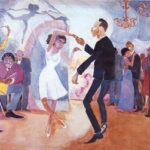In the early 1920s and continuing till the mid Depression years, the cultural explosion of literature, music, and art was harbored mainly in the Harlem neighborhood of New York City. The Harlem Renaissance, also known as the “New Negro Movement,” embodied a common belief in black pride and motivated many African Americans to celebrate their heritage through literature and art (Wintz 36). Not only did the Harlem Renaissance influence racial ideologies, but literature drastically blossomed during this era. The Negro Renaissance allowed African American literary works to be displayed on a mainstream level which attracted significant attention from critics and patrons (Wintz 67). The literary progress during the Harlem Renaissance inflamed a new awareness for African American writers which modern African American writers still emulate in their works. The significant change in African American mindsets has endured throughout most of the twenty century and persists even to this day.
“If you believe that the Negro has a soul, if you believe that the Negro is a man, if you believe the Negro was endowed with the senses commonly given to other men by the Creator, then you must acknowledge that what other men have done, Negroes can do. We want to build up cities, nations, governments, industries of our own in Africa, so that we will be able to have a chance to rise from the lowest to the highest position in the African Commonwealth” (Garvey 1).
In the captivating speech, “If You Believe the Negro Has a Soul,” Marcus Garvey emphasized a new philosophy for African Americans known as the “Back to Africa” movement. The ideas surrounding the “Back to Africa” movement established a new sense of pride and planted the foundation for advancements during the Harlem Renaissance. The New Negro Movement originated out of Harlem because of the vast opportunities in business and education that were unavailable in the South (Reuben 9). The failure of Reconstruction left freed slaves subject to cruel laws and intimidation by white supremacists. In the heart of Manhattan, land had been allotted by chance for African Americans that had traversed over the Mason Dixon in order to escape lynching and Jim Crow Laws (Mullen 43). Due to the Great Migration, thousands of black Americans took advantage of employment opportunities and it developed into a political and cultural center (Wintz 55). Such political activists who influenced northern migrators were Marcus Garvey and W. E. B. Du Bois who advocated African pride and the improvement of black rights. Cultural pride and increases in education provided young authors and poets the courage and intellect to express African American literature with a new ambition which received national recognition.
During the 1920s and early Depression years, many works of literature erupted from African American authors and poets. The primary literary novel that started mainstream publishing of African American works was Cane by Jean Toomer (Wintz 182). Other works of art were books of poetry by Langston Hughes called the The Weary Blues and Color by Countee Cullen which had great influences on other writers of the “New Negro Movement.” Claude McKay wrote Home to Harlem which was one of the most popular African American novel during the 1920s and focused on Harlem nightlife and an inside perspective of the lives of black people. Marcus Garvey, who started the “Back to Africa” movement, probably had the most extreme views of the Harlem Renaissance when writing because he would use volatile language to stir up crowds and even named himself the Provisional President of Africa. Alain Locke, after writing “The New Negro” in 1925, had invented a term that was the epitome of a “new age” African American in Harlem (Carbado 13).
Jean Toomer’s Cane commenced the literary movement during the Harlem Renaissance and received grand reviews from white critics which allowed other African Americans to start writing as well. Cane was considered to be a masterpiece when first published in 1923 and Toomer seemed to be the young leading star that the inhabitants of Harlem would congregate around. However, after Cane, Toomer refused to write anymore racial novels, and his religious journey led him to the Religious Society of Friends (Hulett 2). Due to his family’s genealogy, he detested the notation that he was a black writer writing about black issues and severed all ties between Harlem writers (Wintz 110). This fallout devastated his reputation and he was lost in ambiguity until his works were reprinted and republished in 1969. Since then, Cane has become a classical text for African American studies in college and is a prime example of influence towards modern authors. Such contemporary authors to be influenced by his novel were Alice Walker who wrote The Color Purple (Hulett 2). “I remember reading Cane for the first time with a passionate recognition of a kinder love and weeping over the poem about there always needing to be, and there always being, someone who becomes a seed that gives us once again the singing, shining tree” (White 212). In her biography, Alice Walker: A Life by Evelyn C. White, she explained that Cane was a model for each of her short stories and was the driving force that helped in her writing.
The most renowned poet of the Harlem Renaissance was Langston Hughes, whose poems are still recited and influence many contemporary writers. Hughes first poem was The Weary Blues, which seemed to reflect the new style of music in the 1920s. His poems use a refrain and rhythm to incite the reader to feel the tempo and sad tones as the blues musicians once played them (Rueben 9). Langston Hughes influenced many jazz musicians with his poetry, but his poetry also influenced one of the most popular black figures in America, Martin Luther King Jr. Although Hughes was non-religious and some of his poems were deemed blasphemy, his poem I, Too, Dream America, inspired King’s “I Have a Dream” speech (Allen 3). Langston Hughes’s poems displayed realism, symbolism, and typical African American lifestyles in his literary works which established his enormous popularity (Rueben 9). Hughes popularity and influence among modern writers continues even to this day.
Claude McKay wrote one the most popular African American novels during the Harlem Renaissance. Home to Harlem embodied the emotions and feelings of a majority of African Americans who either fought in World War I or enjoyed the night life of Harlem (Rueben 9). The novel based its plot around a loveable character named Jake who had served in the army during World War I, and returns home to Baltimore, but is forced to move to Harlem because jobs are scarce. The character Jake represents a large population of war veterans who were returning home only to discover that no job opportunities were available. The story develops into a love story about Jake’s “lost brown”, and while he travels around Harlem his friendships, loves, jobs and nightlife are displayed vividly throughout the novel. Although McKay butted heads with Alan Locke over what the “New Negro” would represent, he compelled many writers of the 20th century to start and many copied his style of writing. Claude McKay influenced Amiri Baraka, who is a famous teacher and writer that uses McKay’s techniques as a writer and Malcom X’s message in his works (Salaam 3). “When you imitate people’s writings, you also imitate their point of view. I wrote a long paper on something called the ‘content of form.’ Forms are a form of content. When Claude McKay focuses on certain forms that describe his philosophy those then become my philosophy. I began to see that being influenced by him allowed me to be inspired by his content” (Salaam 5). Amiri Baraka often uses references from Home to Harlem in order to portray the significance of many themes in his works. Claude McKay’s works have an everlasting effect on contemporary writers similar to Amiri Baraka.
The Black Nationalist, Marcus Garvey, had been the most influential person during the Harlem Renaissance. He noticed the injustices and hardships of blacks around the world and created the Universal Negro Improvement Association (U.N.I.A.), which called for all blacks to band together. “It is for me to inform you that the Universal Negro Improvement Association is an organization that seeks to unite, into one solid body, the four hundred million Negroes in the world” (Garvey 1). Garvey wanted complete unity among blacks and, more importantly, he demanded that all should depart to the homeland, Africa. The “Back to Africa” movement was the main driving force behind the start of the “New Negro Movement,” thus instigating a myriad of African Americans to experience a sense of pride. Writers of the Harlem Renaissance had a new found courage to inscribe words of hope to other African Americans (Rueben 9). Garvey’s “If You Believe the Negro Has a Soul” speech in 1921, influenced every African American writer during the Harlem Renaissance and therefore can be traced back to influencing current authors and poets. Garvey exclaimed that:
We want to unite the Negro race in this country. We want every Negro to work for one common object, that of building a nation of his own on the great continent of Africa. That all Negroes all over the world are working for the establishment of a government in Africa, means that it will be realized in another few years. We want the moral and financial support of every Negro to make this dream a possibility. Our race, this organization, has established itself in Nigeria, West Africa, and it endeavors to do all possible to develop that Negro country to become a great industrial and commercial commonwealth. Pioneers have been sent by this organization to Nigeria, and they are now laying the foundations upon which the four hundred million Negroes of the world will build (Garvey 1).
Despite starting the “Movement,” Garvey never actually enacted his plan of transporting millions of African Americans back to Africa (Wintz 110). His scheme fell apart after he began referring to himself as the Provisional President of Africa. The United States government arrested him for seditious acts and mail fraud. While in an Atlanta Penitentiary, Garvey wrote: “Be assured that I planted well the seed of Negro or Black Nationalism which cannot be destroyed even by the foul play that has been meted out to me. His influences on African American literature transcend individual authors and poets and encompass all African American works of art.
The New Negro, written and published by Alain Locke established a new term for African Americans in Harlem and created another alias for the Harlem Renaissance, “The New Negro Movement.” Alain Locke’s “New Negro” had become the standards for all African Americans and started a new wave of literature during the mid 1920s. Locke had built a collection of essays, stories, and poems and developed the concept of the “New Negro” (Carbado 15). With the publication of The New Negro, Locke became the leading theoretician and strategist of the “New Negro Movement” (Rueben 9). Locke had been a philosopher at Howard University before writing The New Negro and he viewed the Harlem Renaissance as a cultural revolution. His philosophies on the “New Negro Movement” led to the new discoveries of cultural pluralism, value relativism, and critical relativism (Hemenway 10). His views on the Harlem Renaissance differed significantly from W.E.B. Du Bois, who thought of the works in the “New Movement” as a means of propaganda, whereas Locke considered it as a self-expression and spiritual growth (Rueben 9). He influenced Zora Neale Hurston with the novel The New Negro and Toni Morrison whom he met while teaching at Howard University. Although Zora Neale Hurston wrote during the Harlem Renaissance, her works had a tremendous impact from Locke. He introduced her to writing and eventually supplied her with money to continue writing. Zora Neale Hurston’s most famous novel, Their Eyes Were Watching God had been inspired by Locke’s philosphies (Rueben 9). Toni Morrison was another author to be influenced by Locke. She is a Nobel Prize winner in literature and a Pulitzer Prize winner in Fiction for her novel Beloved (Wintz 56). During his time teaching at Howard University, Locke and Morrison became part of an informal group of poets and authors, and Morrison evolved into a literay scholar through Locke’s influence. After winning the Nobel Prize in literature, she credited Locke as one of her influences in becoming an author.
The decline of the Harlem Renaissance is attributed to numerous reasons. The Stock Market Crash in 1929 started the beginning of the end by inciting the Great Depression. The Depression caused many white patrons and organizations to cease contributing. Also many influential black writers and poets, including Hughes, Claude McKay, Marcus Garvey, and Du Bois, left New York City in the early 1930s in order to spread their works all over Europe (Wintz 187). The rise of the KKK boosted racial tension and intimidated many of the young talent in writing (Mullen 5). Finally, a riot, due to the growing economic dilemma of the Depression, in 1935 in Harlem elevated tensions between the black and white communities which shattered the notion of Harlem being a renaissance area (Wintz 190). Nevertheless, the “New Negro Movement” did not disappear immediately. The Harlem Renaissance ended when renowned authors and poets left Harlem or stopped writing altogether, while incoming writers never related with the movement during the late 1930s and 1940s
. The Harlem Renaissance established African American literature in the United States and influence many authors throughout the 20th century. African American writers after the “Movement” received less criticism and publishing literature was easier than at the start of the century. Literature from the Harlem Renaissance inspired many contemporary writers such as Alice Walker, Amiri Baraka, and Toni Morrison and also influenced Martin Luther King’s I Have A Dream speech. The time period of the Harlem Renaissance provided crucial advancements in African American Art and Literature. Inspiration from Langston Hughes and Alain Locke are witnessed in modern culture and society. Although the “New Negro Movement” is long since over, the effects of the authors and words written are still prevalent today.
Works Cited
Allen, Norm. “Martin Luther King, Jr. from a Humanist Perspective”. Council for Secular Humanism. Dec 8, 2008
Carbado, Devon W, Dwight A. McBride, and Donald Weise, eds. Black Like Us: A Century of Lesbian, Gay and Bisexual African American Fiction. San Francisco: Cleis Press, 2002.
Garvey, Marcus. If You Believe the Negro Has a Soul: Back to Africa. Los Angeles: Vincent Voice Library, 1921.
Hemenway, Robert E. Zora Neale Hurston: A Literary Biography. Urbana: University of Illinois Press, 2007.
Hulett, Keith. “Jean Toomer (1894-1967)”. The New Georgia Encyclopedia. Dec 7, 2008 .
Karrer, Wolfgang. “Black Modernism? The Early Poetry of Jean Toomer and Claude McKay.” Jean Toomer and the Harlem Renaissance. Genevieve Fabre and Michel Feith, eds. Piscataway, New Jersey: Rutgers University Press, 2001.
Mullen, Edward J., ed. The Harlem Group of Negro Writers by Melvin B. Tolson. Westport, Connecticut: Greenwood Press, 2001.
Reuben, Paul P. “Chapter 9: Harlem Renaissance – An Introduction.” PAL: Perspectives in American Literature- A Research and Reference Guide, Dec 7, 2008.
Salaam, Kalamu. “A Conversation with Amiri Baraka”. Modern American Poetry. Dec 8, 2008 .
White, Evelyn. Alice Walker: A Life. W. W. Norton & Company, 2004.
Wintz, Cary. “Harlem Renaissance” Encarta Online Encyclopedia, Dec 7, 2008.
Wintz, Cary. Black Culture and the Harlem Renaissance. Houston, TX: Rice University Press, 1988.






